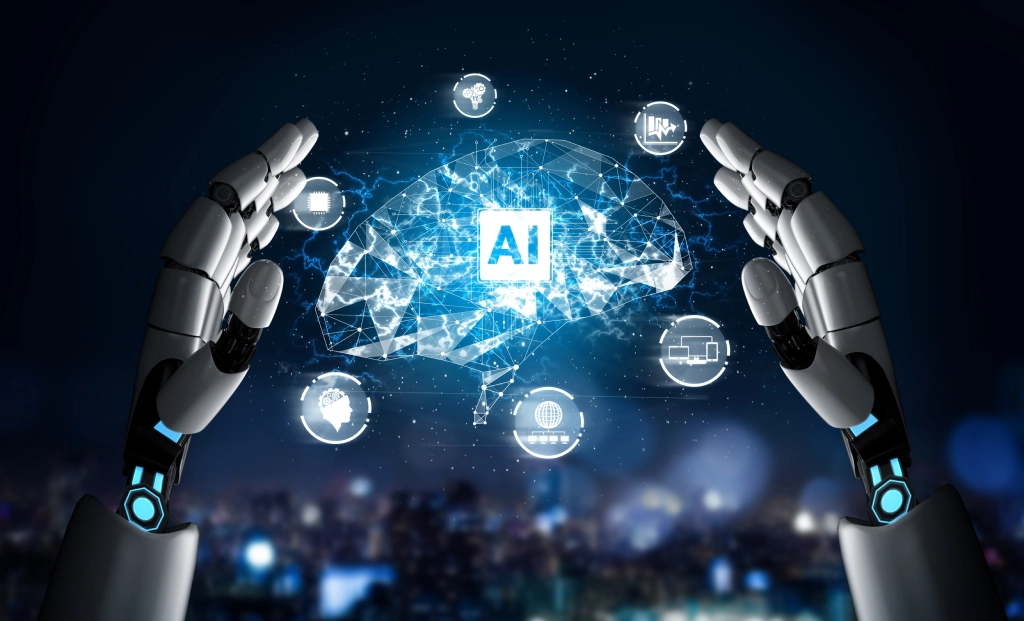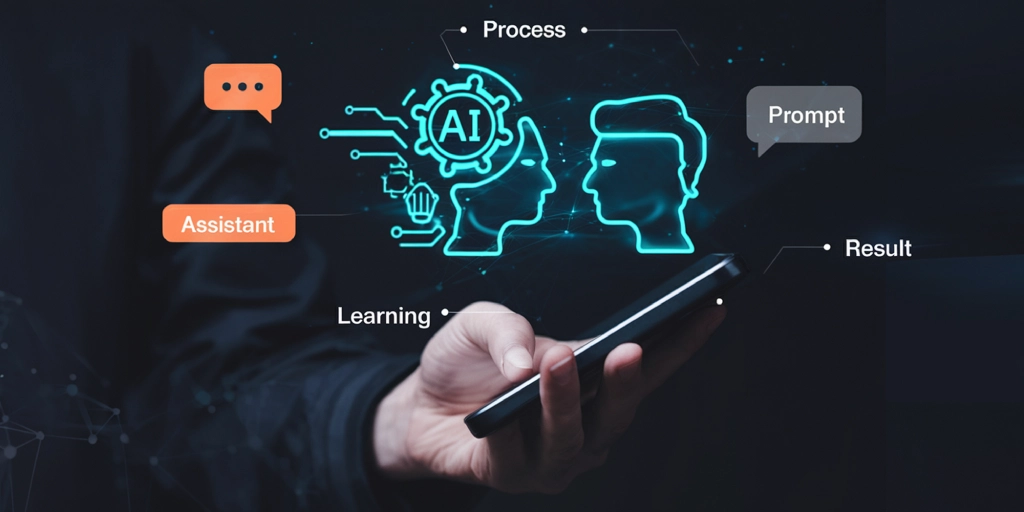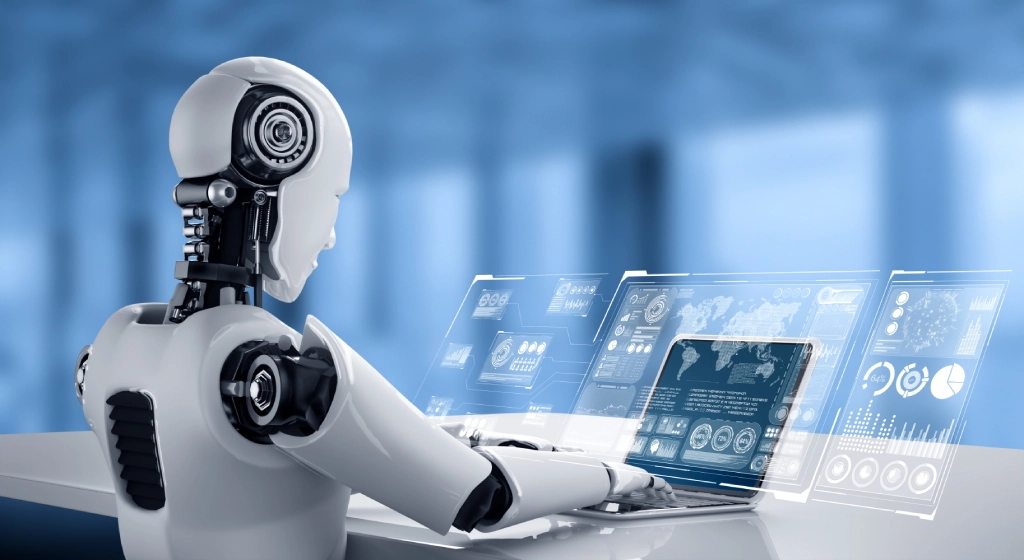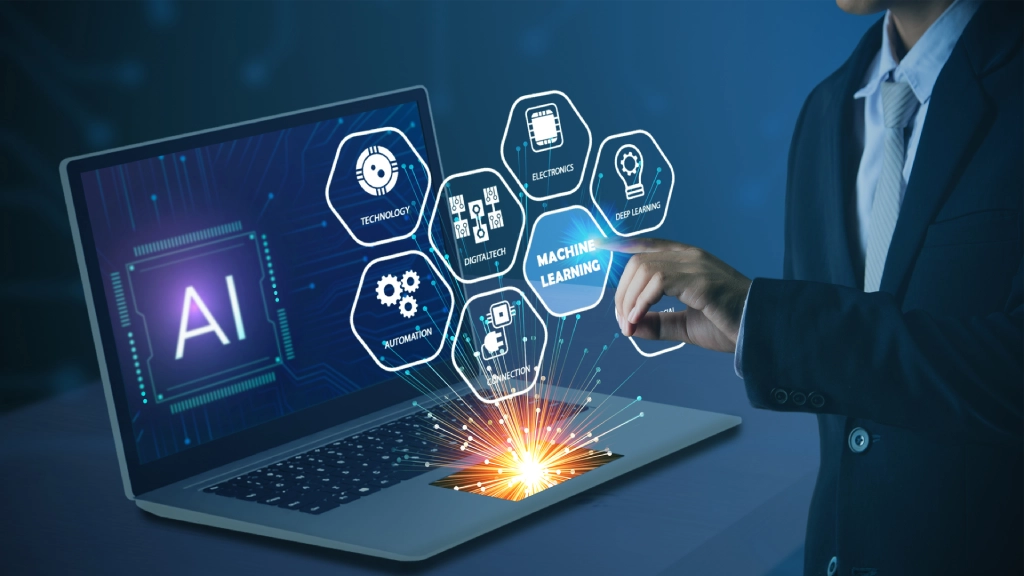Table of Contents
ToggleArtificial Intelligence (AI) is not just the future—it’s the intelligent force reshaping our tech world today.
Artificial intelligence and digital transformation are transforming the way we live, work, and interact with technology. From smart assistants to predictive healthcare tools, AI is at the core of modern innovation.
But what exactly is the goal of artificial intelligence?
It is a common question, and you are probably searching for the exact answer.
In this blog, we will explore its purpose of AI, types, list some applications of artificial intelligence, and the impact it’s making across industries.
What is Artificial Intelligence?
The role of Artificial Intelligence (AI) is the ability of machines to think, learn, and make decisions like humans. It uses machine learning applications to analyze data, solve problems, and improve over time.
From AI-powered automation in industries to natural language processing tools like chatbots, the purpose of AI is to transform how we work and live. Whether it’s healthcare or AI in finance, AI helps make smarter, faster, and more accurate decisions.
The main goal of generative AI is to mimic human intelligence to perform tasks such as speech recognition, image analysis, and decision-making. With continuous learning, AI is becoming an essential part of our everyday lives.

Types of Artificial Intelligence
Artificial Intelligence is categorized based on its capabilities and functionalities. These types range from simple, task-specific systems to advanced machines that aim to replicate human thinking.
Let’s explore the different types of AI and how they function.
| Type | Description |
| Narrow or Weak AI | Focused on a single task (e.g., Siri, Google Assistant). |
| General or Strong AI | Mimics human cognition across a wide range of tasks (still hypothetical). |
| Artificial Narrow Intelligence (ANI) | Specializes in one task with predefined boundaries. |
| Artificial General Intelligence (AGI) | Performs any intellectual task a human can do. |
| Artificial Superintelligence | Exceeds human intelligence across all fields. |
| Reactive Machines | Respond to specific stimuli without memory (e.g., IBM’s Deep Blue). |
| Limited Memory | Remembers past data for a short time (e.g., self-driving cars). |
| Theory of Mind AI | Can understand emotions, beliefs, and intentions (currently in research). |
What are the Goals of Artificial Intelligence?
1. Automate repetitive tasks
One of the primary goals of AI is to automate tasks that are routine, time-consuming, or prone to human error. Using AI-powered automation, businesses can manage operations, save time, and cut costs. From data entry to customer service chatbots, automation improves efficiency across industries like ecommerce, healthcare, and manufacturing.
2. Mimicking human intelligence
One of the main goals of Artificial Intelligence is to simulate how humans think, learn, and make decisions using neural network models and deep learning techniques.
The main goal of artificial intelligence systems is to be trained to recognize patterns, understand emotions, and even reason logically. By mimicking human intelligence, AI aims to create machines that can adapt to new situations just like humans do, enabling smarter and more flexible applications.
3. Improving decision-making
With access to large datasets, AI uses predictive analytics software to identify trends and make accurate forecasts.
This helps professionals in healthcare, AI in finance, and other sectors make better, data-driven decisions. For example, doctors can detect diseases early, and financial analysts can spot investment opportunities or risks faster than ever before. The goal of AI here is to reduce human error and improve outcomes.
(Also Read: How AI Detects Fraud in Banking Apps)
4. Increasing human capabilities
AI acts as a powerful assistant, increasing what humans can do by providing real-time insights, automation, and support. In AI in healthcare, it helps doctors with diagnostic tools; in education, it personalizes learning experiences; and AI in finance, it assists in managing investments. This synergy between AI and human skills leads to greater productivity and smarter solutions in day-to-day life and business.
5. Interacting with humans
AI is becoming more natural in how it communicates through natural language processing tools. This allows machines to understand and respond to human speech or text in real time, making interactions smoother and more intuitive.
Virtual assistants, AI chatbots, and customer support systems are prime examples. The objective of AI is to create human-like interactions that increase user experience and accessibility.
6. Understanding and learning from data
AI learns by analyzing vast amounts of data using machine learning applications and computer vision technology. Over time, it becomes smarter and more accurate in predicting outcomes or making decisions.
This continuous learning process allows AI to adapt, improve, and remain relevant even as conditions or user needs change. It’s what powers everything from product recommendations to medical diagnostics.
7. Solve complex problems in real-time
AI excels at solving critical problems quickly and accurately. In AI in autonomous vehicles, it uses computer vision technology to make instant driving decisions. In fintech, AI detects fraudulent activities in real time.
In healthcare, it assists with emergency diagnoses. Real-time problem-solving is a key milestone in AI web development.
8. Personalize user experiences
Another important goal of AI is personalization. AI tracks user behavior and preferences to offer personalized recommendations—be it products, music, or educational content.
Platforms like Netflix, Amazon, and Spotify use predictive analytics software and machine learning to improve user satisfaction and engagement through personalized experiences.

9. Increase efficiency across industries
AI helps businesses increase productivity by minimizing waste and optimizing resource use. In fields like supply chain management, AI-powered automation forecasts demand and monitors inventory levels.
In the food and restaurant industries, AI predicts customer trends and improves service delivery, ultimately saving time and increasing profits.
10. Promote innovation and future technology
AI is the backbone of future tech innovations, from robotics and AI integration to smart cities and space exploration. The aim of artificial intelligence is not just to support current systems but to drive the creation of entirely new possibilities.
As AI evolves, it opens up opportunities in fields we have only imagined, pushing the boundaries of what technology can do.
(Also Read: Ways How AI Innovation Shaping The Future of the Mobile App Market)
Applications of Artificial Intelligence
To define AI and its applications are diverse and rapidly expanding across every industry, driving innovation and smarter solutions. From AI-powered automation to intelligent analytics, Below is the list some applications of artificial intelligence as follows:
1. Natural Language Processing (NLP)
Natural language processing tools help machines understand and respond to human language, both spoken and written. AI is used in tools like chatbots, voice assistants (Alexa, Siri), and real-time translation apps (Google Translate).
NLP improves communication between humans and machines in customer service, healthcare, and content generation.
2. Computer Vision
Computer vision technology allows AI to interpret and analyze visual information from the world, such as images and videos. It’s used in facial recognition, object detection, quality inspection in manufacturing, and autonomous vehicles. This application of Artificial Intelligence increases automation, safety, and security.
3. Machine Learning
The goals and applications of machine learning involve training computers to learn from data and improve their performance over time without being explicitly programmed. Machine learning applications power recommendation engines, fraud detection, spam filtering, and medical diagnosis tools. It forms the foundation of many modern AI systems.
4. Robotics
Robotics combined with AI enables machines to perform tasks that usually require human effort. From AI-powered automation in factories to humanoid robots in healthcare and hospitality, robotics improves productivity and reduces manual labor. Robotics and AI integration also assist in surgeries, warehouse management, and exploration missions.

5. E-Commerce
AI is widely used in e-commerce to personalize product recommendations, optimize pricing, and improve inventory management. AI chatbots offer 24/7 customer support, while predictive analytics software helps businesses understand customer behavior. AI increases user experience and increases sales.
6. Education
AI in education personalizes learning experiences based on student performance and preferences. It powers virtual tutors, automatic grading systems, and AI-powered automation for administrative tasks. AI also enables accessibility tools like speech-to-text for students with special needs.
7. Lifestyle
From smart homes to digital assistants, AI enhances everyday life. AI helps in managing schedules, playing music, automating lights and appliances, and offering health tracking in wearables. It brings convenience, comfort, and customization to our daily routines.
8. Face Recognition
AI-driven face recognition technology is used in security systems, mobile phone unlocking, and identity verification. It works using computer vision technology to detect and match human faces with stored data. It’s widely adopted in airports, banks, and smartphones.
9. AI in Healthcare
AI plays a major role in diagnostics, drug discovery, robotic surgeries, and patient monitoring. AI in healthcare uses machine learning applications to detect diseases early and recommend personalized treatments. It helps doctors make accurate and faster decisions for better patient outcomes.
(Also Read: How much does it cost to build a Healthcare App Like Healthmug?)
10. Artificial Intelligence in GPS and Navigation
AI improves GPS and navigation systems by analyzing real-time traffic, road conditions, and driver behavior. It suggests faster routes, predicts delays, and increases safety through smart routing.
Self-driving cars also rely heavily on AI-powered GPS and computer vision technology.
(Also Read: AI, Data, and Digital Transformation: Are You Harnessing Their Full Potential?)
How Does Alphaklick Help You Build Web and Mobile App Development Using AI?
At Alphaklick, we specialize in building intelligent, high-performing web and mobile applications by using the power of AI technologies. From AI-powered automation and machine learning applications to natural language processing tools and smart analytics, we create digital solutions that are fast, scalable, and user-centric.
With several years of experience, our expert team has successfully delivered numerous AI-integrated websites and mobile apps featuring real-time chatbots, personalized user experiences, smart recommendations, and more.
If you are a startup or an established business, you can contact us for your AI-powered website development and mobile app development needs. We understand how to merge innovation with your goals to help you stay ahead in the digital world.
Let’s build something smart, efficient, and future-ready—together.
FAQs
1. What is the main goal of artificial intelligence?
The main goal of artificial intelligence is to create intelligent machines that can perform tasks that typically require human intelligence—such as learning, reasoning, problem-solving, and understanding language.
2. What is the original goal of AI?
The original goal of AI was to understand and replicate human intelligence, creating machines that could solve problems, reason, and learn like humans.
3. What is the future of AI?
The future of AI includes advancements in Artificial General Intelligence (AGI), deeper AI-human collaboration, enhanced ethical frameworks, and broader applications in all walks of life from smart cities to space exploration.
4. What is the general purpose of artificial intelligence?
The general purpose of artificial intelligence is to develop machines that can improve decision-making, increase efficiency, solve problems, and augment human capabilities across domains.
5. Is AI good or bad?
AI is a tool—it’s neither inherently good nor bad. Its impact depends on how it’s used. Ethical AI development is key to ensuring it benefits society.





















